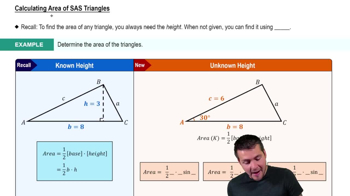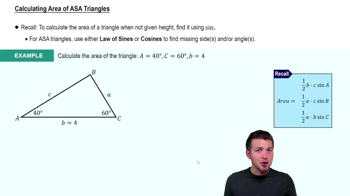Table of contents
- 0. Review of College Algebra4h 43m
- 1. Measuring Angles39m
- 2. Trigonometric Functions on Right Triangles2h 5m
- 3. Unit Circle1h 19m
- 4. Graphing Trigonometric Functions1h 19m
- 5. Inverse Trigonometric Functions and Basic Trigonometric Equations1h 41m
- 6. Trigonometric Identities and More Equations2h 34m
- 7. Non-Right Triangles1h 38m
- 8. Vectors2h 25m
- 9. Polar Equations2h 5m
- 10. Parametric Equations1h 6m
- 11. Graphing Complex Numbers1h 7m
7. Non-Right Triangles
Law of Cosines
Problem 7.63
Textbook Question
Find the exact area of each triangle using the formula 𝓐 = ½ bh, and then verify that Heron's formula gives the same result.
<IMAGE>
 Verified step by step guidance
Verified step by step guidance1
Identify the base (b) and height (h) of the triangle from the given image. The base is typically one side of the triangle, and the height is the perpendicular distance from this base to the opposite vertex.
Apply the area formula for a triangle, \( A = \frac{1}{2} bh \), by substituting the values of base and height that you identified.
To use Heron's formula, first calculate the semi-perimeter of the triangle, which is half the sum of all three sides, \( s = \frac{a+b+c}{2} \), where a, b, and c are the lengths of the sides of the triangle.
Apply Heron's formula: \( A = \sqrt{s(s-a)(s-b)(s-c)} \), where s is the semi-perimeter calculated in the previous step, and a, b, and c are the side lengths of the triangle.
Compare the area obtained from the basic area formula \( \frac{1}{2} bh \) with the area obtained from Heron's formula to verify if they give the same result.
Was this helpful?
Key Concepts
Here are the essential concepts you must grasp in order to answer the question correctly.
Area of a Triangle
The area of a triangle can be calculated using the formula A = ½ bh, where 'b' represents the base and 'h' represents the height. This formula is derived from the fact that a triangle is essentially half of a rectangle formed by the base and height. Understanding how to identify the base and height in various triangle orientations is crucial for applying this formula correctly.
Recommended video:

Calculating Area of SAS Triangles
Heron's Formula
Heron's formula provides a method to calculate the area of a triangle when the lengths of all three sides are known. The formula is A = √(s(s-a)(s-b)(s-c)), where 's' is the semi-perimeter of the triangle, calculated as s = (a+b+c)/2. This formula is particularly useful for triangles where height is not easily determined, allowing for area calculation based solely on side lengths.
Recommended video:

Quadratic Formula
Verification of Area Formulas
Verifying that two different methods yield the same area involves calculating the area using both formulas and comparing the results. This process reinforces understanding of the geometric principles behind each formula and ensures accuracy in calculations. It also highlights the versatility of different approaches in solving geometric problems.
Recommended video:

Calculating Area of ASA Triangles

 4:35m
4:35mWatch next
Master Intro to Law of Cosines with a bite sized video explanation from Patrick Ford
Start learningRelated Videos
Related Practice









